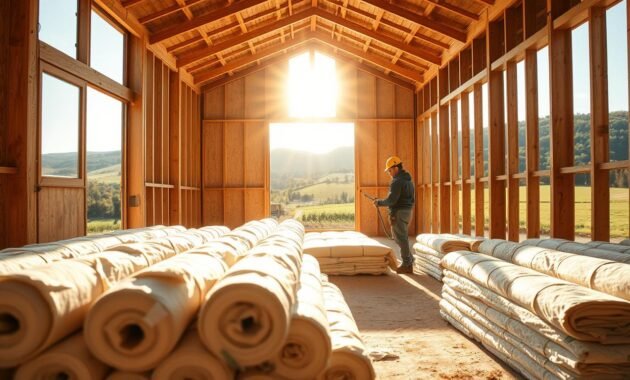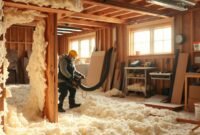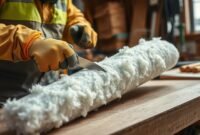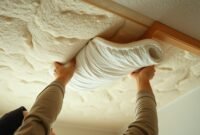Agricultural buildings often have poor temperature control and high energy costs. Drafty pole barns waste money and make working uncomfortable. Traditional insulation doesn’t protect well against heat loss and moisture.
Rigid insulation panels for barns are a game-changer. Foam board pole barn insulation keeps ceilings and walls warm. This guide will help you choose, install, and use foam board insulation in your barns.
Ready to make your pole barn energy-efficient and comfortable? It will save you money and protect your investments.
Understanding Rigid Foam Insulation for Agricultural Buildings
Rigid foam insulation is a top choice for pole buildings. As a farmer, I’ve seen how it keeps buildings cool for animals and equipment. The right foam board can really help.

Rigid foam insulation is better than old materials for farms. It’s light, easy to put up, and keeps buildings warm or cool well.
Types of Rigid Foam Materials
There are three main types of rigid foam for farms:
- Expanded Polystyrene (EPS)
- Extruded Polystyrene (XPS)
- Polyisocyanurate (Polyiso)
Basic Components and Structure
Rigid foam panels have special air traps. This makes them strong thermal barriers. They also stop moisture and keep insulating well.
Importance of R-Value in Farm Buildings
R-value is key for farm insulation. A higher R-value means better heat control. This keeps animals safe and saves on energy costs.
| Foam Type | Typical R-Value per Inch | Best Use |
|---|---|---|
| EPS | 3.6 – 4.2 | General agricultural applications |
| XPS | 4.5 – 5.0 | Moisture-prone environments |
| Polyiso | 5.5 – 6.0 | High-performance insulation needs |
Benefits of Foam Board Pole Barn Insulation
When it comes to keeping barns warm or cool, foam board insulation is a top pick. I’ve seen how it changes agricultural buildings, making them better protected and more efficient.
Read also: Best Adhesive for Foam Board to Concrete
The main benefits of foam board insulation are:
- It’s very strong and doesn’t move after it’s put in place
- It keeps water and moisture out
- It stops pests from getting in
- It makes a good seal to keep air out
XPS foam is special for pole barns because it’s rigid. This means it keeps buildings warm or cool for a long time. It helps farmers keep their buildings at the right temperature, no matter the weather outside.
| Insulation Type | Key Benefits | Best Used For |
|---|---|---|
| XPS Foam | High moisture resistance | Exterior walls and foundations |
| Polyiso | Superior thermal performance | Roof and ceiling applications |
Choosing quality foam board insulation makes your farm more comfortable and saves money. It’s a smart choice for today’s farm buildings.
Cost Analysis and Budget Considerations
Choosing diy pole barn insulation materials can save money for farmers and agricultural experts. Knowing the costs of closed cell foam board installation helps you pick the best option for your barn’s energy use.
Insulation costs are a big factor. The initial cost might seem high, but the long-term savings are worth it. Here are the main financial points to think about for your pole barn insulation project.
Initial Installation Expenses
The price of diy pole barn insulation materials depends on a few things:
- Square footage of your barn
- Type of foam board you choose
- How hard it is to install the foam board
- Local labor costs (if you hire someone)
Long-term Energy Savings
Good insulation can cut down on heating and cooling bills. Closed cell foam board keeps your barn comfy all year. I’ve seen farmers save up to 30% on energy with the right insulation.
Return on Investment Calculations
To figure out your savings, consider these points:
- Look at your current energy bills
- Figure out the cost of insulation and installation
- Guess how much you’ll save on energy each year
- Find out how long it’ll take to pay back your investment
The upfront cost of diy pole barn insulation materials is between $1.50 and $3.00 per square foot. But the long-term savings make it a smart choice for any farm building.
Installation Methods and Best Practices

Installing foam board pole barn insulation is easy if you know how. I’ll show you the steps to make your barn more energy efficient. This will help you save money and keep your barn cozy.
First, get your materials ready and clear the area. You’ll need:
- Foam board insulation panels
- Measuring tape
- Utility knife
- Protective gear
- Adhesive or mechanical fasteners
Foam board insulation is great because it’s easy to cut and fit. It’s perfect for pole barns. Always measure twice and cut once to avoid waste and ensure a good fit.
When installing, focus on a tight seal. Gaps can make the insulation less effective. Use foam gun sealant or special tape to seal any air leaks between panels.
Here are some important tips:
- Clean the surface before you start
- Check for damage or moisture
- Make sure there’s good ventilation
- Wear the right safety gear
- Follow the manufacturer’s instructions
By following these steps, you can get professional-quality insulation. This will make your barn more energy efficient and protect your investment.
Comparing Different Foam Board Types for Pole Barns
Choosing the right insulation for your pole barn is key. Knowing the differences between foam board types can greatly improve your barn’s performance. Let’s explore the main options to help you choose the best for your project.
When picking xps foam for pole barns, you have three main choices. Each foam board type has its own benefits for farm buildings, depending on your needs.
Expanded Polystyrene (EPS)
EPS is the most affordable option for insulation. It’s light and cheap, making it perfect for farmers who want to save money upfront.
- Lower cost compared to other foam insulation types
- Lightweight and easy to install
- Good thermal performance for basic applications
Extruded Polystyrene (XPS)
XPS foam is the best at keeping moisture out. It’s great for areas where water might be a problem, like below grade.
- Exceptional moisture resistance
- High compressive strength
- Ideal for challenging environmental conditions
Polyisocyanurate (ISO)
Polyiso insulation is the greenest choice. It has a high R-value, meaning it insulates well, and is eco-friendly.
| Insulation Type | R-Value per Inch | Moisture Resistance | Cost |
|---|---|---|---|
| EPS | 3.6-4.0 | Moderate | Low |
| XPS | 5.0 | High | Medium |
| Polyiso | 5.5-6.0 | Good | High |
Before making a choice, think about your barn’s needs, the climate, and your budget. Each foam board type has its own advantages for agricultural buildings.
Moisture Management and Vapor Barriers
Keeping moisture out is key for insulating agricultural structures. In pole barns, too much moisture can harm the building and stored items. Foam board thermal barriers are great for controlling humidity and stopping structural problems.
Closed cell foam board is better at keeping moisture out than old insulation. These foam boards make a strong barrier against water, keeping the inside of buildings dry and stable.
Read also: Do Interior Walls Need Insulation?
- Prevents condensation buildup
- Blocks water vapor transmission
- Reduces risk of mold and mildew growth
- Enhances overall building durability
Choosing the right foam board is important for managing moisture. High-performance foam boards protect against water damage and keep your building strong.
| Foam Board Type | Moisture Resistance | Recommended Use |
|---|---|---|
| Closed Cell Polyisocyanurate | Excellent | Perimeter Walls |
| Extruded Polystyrene | Very Good | Foundation Areas |
| Expanded Polystyrene | Good | Interior Spaces |
How you install foam board thermal barriers matters a lot. Make sure to cover everything well and seal any gaps for the best moisture protection.
Energy Efficiency and Temperature Control
Pole barn owners face unique challenges in keeping the temperature right and saving energy. Foam board thermal barriers are a smart solution for a cozy and affordable barn. I’ve learned that the right insulation can greatly improve temperature control all year round.
Choosing the right insulation can make a big difference in your barn’s warmth. Here are the main ways to boost energy efficiency:
- Minimize heat transfer through strategic foam board placement
- Create complete thermal barriers around structural parts
- Pick insulation that fits your local climate
Seasonal Performance Insights
Each season needs its own insulation strategy. In winter, foam board keeps the heat in and cold out. In summer, it reflects the sun’s rays, keeping the barn cool.
| Season | Insulation Performance | Energy Savings |
|---|---|---|
| Winter | Reduces heat loss | 15-25% less heating cost |
| Summer | Blocks solar heat | 10-20% less cooling cost |
Heat Loss Prevention Strategies
To stop heat loss, focus on key areas like wall joints and roof connections. Foam board insulation makes a solid thermal barrier, cutting down on energy waste.
Climate Zone Considerations
Choosing the right insulation depends on your climate. Areas with very hot or cold temperatures need insulation with a higher R-value. Talking to local experts can help you find the best insulation for your barn.
Common Installation Challenges and Solutions
Installing foam board pole barn insulation can be tricky, even for DIY experts. I’ve faced many challenges while working with diy pole barn insulation materials. These challenges can make the process harder than expected.
One big problem is dealing with uneven surfaces. Closed cell foam board installation needs careful preparation and precise cutting for a perfect fit. Here are some steps to overcome common installation challenges:
- Measure twice and cut once to minimize waste of foam board pole barn insulation materials
- Use a sharp utility knife for clean, precise cuts
- Create a template for complex or unusual wall sections
- Check for level surfaces before beginning installation
Managing moisture is another big challenge. Even small gaps can ruin the insulation’s effectiveness. Use high-quality foam board tape or special sealants to seal any air or moisture entry points. Pay extra attention to corners, edges, and joints where gaps are most likely to occur.
Temperature can also affect the installation. Working in very cold or hot conditions can harm the foam board’s performance and your work. Choose moderate weather for your insulation project. Also, let materials get used to the barn’s temperature before you start.
Wearing proper safety gear is key when working with foam insulation. Always wear protective clothing, gloves, and a mask to avoid skin irritation and respiratory issues. Taking these precautions will help you finish your pole barn insulation project safely and successfully.
Maintenance and Long-term Durability
Keeping your agricultural structure insulation in good shape is key. Rigid insulation panels for barns need careful care to keep them working well for a long time.
Looking after foam board thermal barriers is important. It helps them last longer. Let’s talk about how to keep your insulation in great shape.
Pest Resistance Features
Rigid foam insulation is great because it keeps pests out. Its dense material stops:
- Rodents from getting into barns
- Insects from harming other insulation types
- Small animals from making nests
Weather Impact Assessment
Insulation in barns faces many weather challenges. It’s smart to check your foam board thermal barriers often.
| Weather Condition | Potential Impact | Recommended Action |
|---|---|---|
| Extreme Heat | Potential surface degradation | Annual surface inspection |
| High Humidity | Moisture retention risk | Check for water damage signs |
| Freezing Temperatures | Potential material contraction | Seal any developing gaps |
Rigid insulation panels for barns are more durable than old insulation. With a good maintenance plan, your barn’s thermal protection will last longer.
Environmental Impact and Sustainability

When we talk about energy efficient barn insulation, we must think about the planet. Polyiso insulation for farm buildings is a green choice that goes beyond usual insulation. It’s good for the environment and for your farm.
Read also: Cheapest Way to Insulate a Pole Barn?
I’ve looked into the green side of foam insulation, and polyisocyanurate (polyiso) is a standout. It has about 9% recycled content and offers a high R-value of 6.5 per inch. This makes it a top pick for farmers looking for eco-friendly options.
- Polyiso insulation reduces overall carbon footprint
- XPS foam for pole barns provides excellent thermal performance
- Recycled materials contribute to sustainable construction practices
The way rigid foam insulation is made has changed to be kinder to the earth. Companies are working hard to cut down on greenhouse gases and find greener ways to make it. By choosing polyiso, farmers can make their buildings more efficient and help the planet.
Insulation isn’t just about saving energy right now. It’s also about caring for the earth in the long run. The right insulation can cut down on energy use, lower bills, and help make farming more sustainable.
Conclusion
Exploring foam board pole barn insulation has shown me its power. The right insulation can change how your farm works. It’s not just about keeping things warm; it’s about making your farm better.
I found that there are many insulation choices for pole barns. Each one has its own good points. Foam board is a great mix of performance and price. It helps your barn or warehouse work better, no matter what you use it for.
Good insulation keeps your farm safe from extreme weather and moisture. By picking the right insulation, you make your buildings better. This helps them handle different weather conditions.
When choosing insulation, think about what you need, your climate, and your budget. The right choice can save a lot of energy and make your barn last longer. Your pole barn needs the best protection for now and the future.


